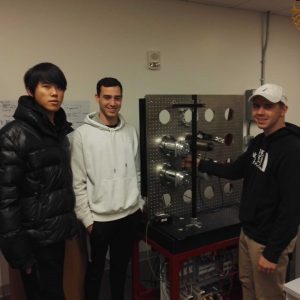 The goal of the project was to develop and fabricate an accurate, precision-based parallelism measurement device for a Roll-to-Roll (R2R) printing machine in the Intelligent Sensing Lab at UMass Amherst. For the printing process to run repeatedly without variance, all aspects of the machine must run accurately, however the principal component for the senior design team to consider for this project were the rollers. The overarching concern with regards to the rollers are their parallelism in the horizontal and vertical planes. If the rollers are not parallel with each other, the printing web that they feed will undergo tension and can potentially tear or crawl along the rollers. If the rollers are not precisely placed into the vertical breadboard of the machine, any testing done cannot be considered accurate and any printing done will not be exact, leading to poor overall printing quality. With these issues in mind a roller displacement measuring tool was conceived and produced in order to evaluate the rollers’ parallelism. The team’s design solution focuses on measuring distances from each roller to a reference beam for horizontal deflection and measuring distances from each roller to one another for vertical deflection. This is done by inserting an aluminum CNC machined square enclosement piece around each roller and using a caliper and caliper extension kit to mate with the aluminum piece and thus measure to the other rollers and reference beam. The project team consisted of four members, Suadad-Al Khamees, Thomas Regensburger, Harry Na, and Dominik Laszczkowski. The significance of Suadad’s contribution to the final product includes leading and organizing team to achieve milestones, developing a successful concept solution to the Roll-to-Roll precision problem that meets our sponsors goals for the project, and compiling a B.O.M as necessary for the final prototype. Due to Thomas’s prior summer research position he held in our client’s lab and the work he did (designed CAD model of R2R assembly in SolidWorks), he led in the design of all the CAD models for the project, which includes all modeled prototypes, the enclosement piece model, and the final assembly. Harry analyzed for potential modes of failure in the team’s various designs via FEA software and engineering application. Dominik assembled the prototype to test its design in order to gather feedback and where the design stood to help define some issues and problems that arose and help better prepare for the upcoming semester. After reaching out to A&D Metal Inc. for assistance with the project, Dominik worked closely with A&D Metal Inc. to establish machining criteria and the process that would allow for necessary design changes to properly and easily machine the team’s collet and adaptor design out of aluminum.
The goal of the project was to develop and fabricate an accurate, precision-based parallelism measurement device for a Roll-to-Roll (R2R) printing machine in the Intelligent Sensing Lab at UMass Amherst. For the printing process to run repeatedly without variance, all aspects of the machine must run accurately, however the principal component for the senior design team to consider for this project were the rollers. The overarching concern with regards to the rollers are their parallelism in the horizontal and vertical planes. If the rollers are not parallel with each other, the printing web that they feed will undergo tension and can potentially tear or crawl along the rollers. If the rollers are not precisely placed into the vertical breadboard of the machine, any testing done cannot be considered accurate and any printing done will not be exact, leading to poor overall printing quality. With these issues in mind a roller displacement measuring tool was conceived and produced in order to evaluate the rollers’ parallelism. The team’s design solution focuses on measuring distances from each roller to a reference beam for horizontal deflection and measuring distances from each roller to one another for vertical deflection. This is done by inserting an aluminum CNC machined square enclosement piece around each roller and using a caliper and caliper extension kit to mate with the aluminum piece and thus measure to the other rollers and reference beam. The project team consisted of four members, Suadad-Al Khamees, Thomas Regensburger, Harry Na, and Dominik Laszczkowski. The significance of Suadad’s contribution to the final product includes leading and organizing team to achieve milestones, developing a successful concept solution to the Roll-to-Roll precision problem that meets our sponsors goals for the project, and compiling a B.O.M as necessary for the final prototype. Due to Thomas’s prior summer research position he held in our client’s lab and the work he did (designed CAD model of R2R assembly in SolidWorks), he led in the design of all the CAD models for the project, which includes all modeled prototypes, the enclosement piece model, and the final assembly. Harry analyzed for potential modes of failure in the team’s various designs via FEA software and engineering application. Dominik assembled the prototype to test its design in order to gather feedback and where the design stood to help define some issues and problems that arose and help better prepare for the upcoming semester. After reaching out to A&D Metal Inc. for assistance with the project, Dominik worked closely with A&D Metal Inc. to establish machining criteria and the process that would allow for necessary design changes to properly and easily machine the team’s collet and adaptor design out of aluminum.

Machine Intelligence + Sensing for R2R flexible electronics printing and medical devices